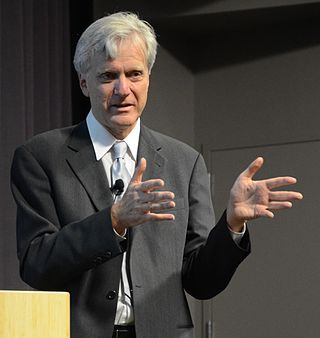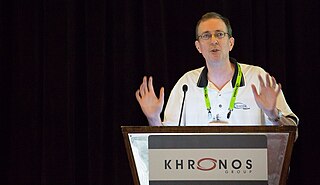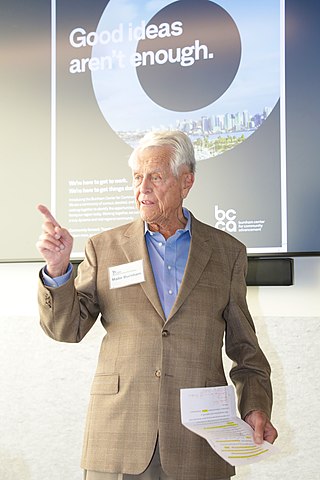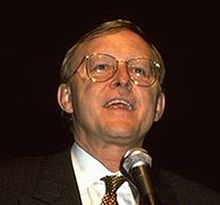
A workstation is a special computer designed for technical or scientific applications. Intended primarily to be used by a single user, they are commonly connected to a local area network and run multi-user operating systems. The term workstation has been used loosely to refer to everything from a mainframe computer terminal to a PC connected to a network, but the most common form refers to the class of hardware offered by several current and defunct companies such as Sun Microsystems, Silicon Graphics, Apollo Computer, DEC, HP, NeXT, and IBM which powered the 3D computer graphics revolution of the late 1990s.

Andreas Maria Maximilian Freiherr von Mauchenheim genannt Bechtolsheim is a German electrical engineer, entrepreneur and investor. He co-founded Sun Microsystems in 1982 and was its chief hardware designer. As of March 2024, Forbes estimated his net worth at $16.3 billion.

Marc Lowell Andreessen is an American businessman and former software engineer. He is the co-author of Mosaic, the first widely used web browser with a graphical user interface; co-founder of Netscape; and co-founder and general partner of Silicon Valley venture capital firm Andreessen Horowitz. He co-founded and later sold the software company Opsware to Hewlett-Packard. Andreessen is also a co-founder of Ning, a company that provides a platform for social networking websites and an inductee in the World Wide Web Hall of Fame. Andreessen's net-worth is estimated at $1.7 billion.

John Leroy Hennessy is an American computer scientist who is chairperson of Alphabet Inc. (Google). Hennessy is one of the founders of MIPS Technologies and Atheros, and also the tenth President of Stanford University. Hennessy announced that he would step down in the summer of 2016. He was succeeded as president by Marc Tessier-Lavigne. Marc Andreessen called him "the godfather of Silicon Valley."
The Computer Graphics Lab is a computer lab located at the New York Institute of Technology (NYIT), founded by the late Dr. Alexander Schure. It was originally located at the "pink building" on the NYIT campus. It has played an important role in the history of computer graphics and animation, as founders of Pixar and Lucasfilm, including Turing Award winners Edwin Catmull and Patrick Hanrahan, began their research there. It is the birthplace of entirely 3D CGI films.
David Ross Cheriton is a Canadian computer scientist, businessman, philanthropist, and venture capitalist. He is a computer science professor at Stanford University, where he founded and leads the Distributed Systems Group.

Kurt Akeley is an American computer graphics engineer.
Wavefront Technologies was a computer graphics company that developed and sold animation software used in Hollywood motion pictures and other industries. It was founded in 1984, in Santa Barbara, California, by Bill Kovacs, Larry Barels, Mark Sylvester. They started the company to produce computer graphics for movies and television commercials, and to market their own software, as there were no off-the-shelf computer animation tools available at the time. In 1995, Wavefront Technologies was acquired by Silicon Graphics, and merged with Alias Research to form Alias|Wavefront.

Patrick M. Hanrahan is an American computer graphics researcher, the Canon USA Professor of Computer Science and Electrical Engineering in the Computer Graphics Laboratory at Stanford University. His research focuses on rendering algorithms, graphics processing units, as well as scientific illustration and visualization. He has received numerous awards, including the 2019 Turing Award.

Kristy Hinze is an Australian model, actress and television host. Hinze has appeared in Sports Illustrated as well as the Victoria's Secret catalogue.
Hyperion is the name of a 155.5-foot (47.4 m) sailing yacht built by the Royal Huisman in the Netherlands in 1998 and designed by German Frers. At the time of her launch, she was the largest sloop ever built, and had the tallest mast. The 194-foot (59 m) carbon-fiber mast clears the deck of the Golden Gate Bridge by only 30 feet (9.1 m).
David James Brown is an American computer scientist. He was one of a small group that helped to develop the system at Stanford University that later resulted in Sun Microsystems, and later was a co-founder of Silicon Graphics in 1982.

The John and Marcia Price College of Engineering at the University of Utah is an academic college of the University of Utah in Salt Lake City, Utah. The college offers undergraduate and graduate degrees in engineering and computer science.

Alexander Schure was an American academic and entrepreneur. Schure founded the New York Institute of Technology (NYIT) in 1955. He also served as the Chancellor of Nova Southeastern University (NSU) from 1970 until 1985.
Charles Stanley "Herb" Kuta is an American electronics engineer and software engineer who was a co-founder of Silicon Graphics, a major graphics workstation manufacturer.

Malin Burnham is an American sailor, real estate developer and philanthropist from San Diego, California.

Julie Hanna is an Egyptian-born technologist, entrepreneur, investor and board director. She serves as Executive Chair of the Board of Kiva., peer-peer lending and crowdfunding pioneer. She is Special Advisor to X, Alphabet's Moonshot Factory and Venture Partner at Obvious Ventures.

The Kahlert School of Computing is a school within the College of Engineering at the University of Utah in Salt Lake City, Utah.
This is the history of Stanford University.
Forest Baskett is an American venture capitalist, computer scientist and former professor of electrical engineering at Stanford University.












